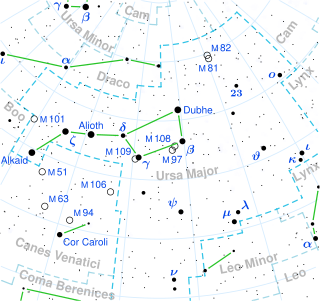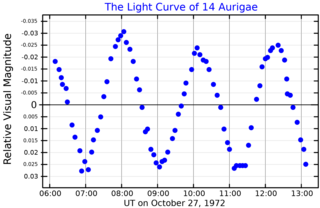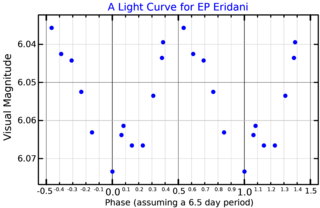
Omega Ursae Majoris is the Bayer designation for a binary star system in the northern circumpolar constellation of Ursa Major. It is visible to the naked eye with an apparent visual magnitude of 4.61. Based upon an annual parallax shift of 13.24 mas, it is roughly 246 light years from the Sun. At that distance, the visual magnitude of the star is diminished by an extinction factor of 0.11 due to interstellar dust.

Tau Ursae Majoris (τ UMa) is the Bayer designation for a binary star in the northern circumpolar constellation of Ursa Major. It is visible to the naked eye, having an apparent visual magnitude of 4.66. With an annual parallax shift of 25.82 mas, it is located about 126 light years from the Sun. At that distance, the visual magnitude is diminished by an extinction factor of 0.19 due to interstellar dust.

9 Aurigae is a star system in Auriga (constellation). It has an apparent magnitude of about 5, making it visible to the naked eye in many suburban skies. Parallax estimates made by the Hipparcos spacecraft put it at about 86 light-years from the solar system, although individual Gaia Data Release 3 parallaxes place all three components at 88 light years.

14 Aurigae is a quadruple star system located 269 light years away from the Sun in the zodiac constellation of Auriga. It has the variable star designation KW Aurigae, whereas 14 Aurigae is the Flamsteed designation. It is visible to the naked eye as a faint, white-hued star with a combined apparent visual magnitude of 5.01. The system is moving closer to the Sun with a heliocentric radial velocity of −9 km/s.
HR 3220 is a binary star system in the southern constellation of Carina. It has the Bayer designation B Carinae; HR 3220 is the designation from the Bright Star Catalogue. It has a yellow-white hue and is visible to the naked eye with an apparent visual magnitude of 4.75. Based upon parallax measurements, it is located at a distance of 59 light years from the Sun. The system is drifting further away with a radial velocity of +24 km/s.
5 Tauri is a binary star in the zodiac constellation of Taurus, located approximately 530 light years from the Sun. It is visible to the naked eye as a faint orange-hued star with an apparent visual magnitude of +4.14. It is moving further from the Earth with a heliocentric radial velocity of +14 km/s.
HR 4458 is a binary star system in the equatorial constellation of Hydra. It has the Gould designation 289 G. Hydrae; HR 4458 is the Bright Star Catalogue designation. At a distance of 31.13 light years, it is the closest star system to the Solar System within this constellation. This object is visible to the naked eye as a dim, orange-hued star with an apparent visual magnitude of 5.97. It is moving closer to the Earth with a heliocentric radial velocity of −22 km/s.

HD 17925 is a variable star in the equatorial constellation of Eridanus. It has the Gould designation 32 G. Eridani and the variable star designation EP Eri. The star has a yellow-orange hue and is dimly visible to the naked eye in good seeing conditions with an apparent visual magnitude that varies from 6.03 down to 6.08. It is located nearby at a distance of 34 light years from the Sun based on parallax, and is drifting further away with a radial velocity of +18 km/s. It is a likely member of the Local Association of nearby, co-moving stars. The spectrum shows a strong abundance of lithium, indicating that it is young star. This likely makes its point of origin the nearby Scorpio–Centaurus Complex.

HR 5553 is a binary star system located thirty-eight light-years away from the Sun, in the northern constellation Boötes. It has the variable star designation DE Boötis, and is classified as an RS Canum Venaticorum variable that ranges in apparent visual magnitude from 5.97 down to 6.04, which is bright enough to be dimly visible to the naked eye. The system is drifting closer to the Sun with a radial velocity of −30 km/s, and is expected to come as close as 26.9 light-years in 210,000 years.

V538 Aurigae is a single star in the northern constellation of Auriga. With an apparent visual magnitude of 6.23, this star requires good dark sky conditions to view with the naked eye. It is located at a distance of 40.0 light-years (12.3 pc) from Sun based on parallax. The star is drifting further away with a radial velocity of 0.9 km/s. It is a member of the Local Association, and is most likely a thin disk star.

HD 128333 or CH Boötis is an irregular variable star in the northern constellation of Boötes. It is currently on the asymptotic giant branch of the HR diagram.
4 Camelopardalis is a probable multiple star in the northern constellation of Camelopardalis, located 177 light years away from the Sun, based upon parallax. With a combined apparent visual magnitude of 5.29, it is visible to the naked eye as a faint, white-hued star. The pair have a relatively high proper motion, traversing the celestial sphere at an angular rate of 0.158″ per year. The system's proper motion makes it a candidate for membership in the IC 2391 supercluster. They are moving away from the Earth with a heliocentric radial velocity of 22.5 km/s.
39 Draconis is a wide binary star system in the northern circumpolar constellation of Draco. It has the Bayer designation b Draconis, while 39 Draconis is the Flamsteed designation. This system is visible to the naked eye as a dim, white-hued point of light with an apparent visual magnitude of 5.0. Parallax measurements made by the Hipparcos spacecraft put it at a distance of 184 light-years, or 56 parsecs away from the Sun. The system is moving closer to the Earth with a heliocentric radial velocity of -24.5 km/s.

1 Geminorum is a star in the constellation Gemini. Its apparent magnitude is 4.15.
Mu Lupi is a system of three or four stars in the southern constellation of Lupus. It is visible to the naked eye with an apparent visual magnitude of 4.29 and lies roughly 340 light-years from the Sun.

Zeta1 Lyrae, Latinized from ζ1 Lyrae, is a binary star in the northern constellation of Lyra. Based upon an annual parallax shift of 20.89 mas as seen from Earth, the pair are located about 156 light years from the Sun. It is visible to the naked eye with an apparent visual magnitude of 4.37.
16 Serpentis is a binary star system in the Serpens Caput portion of the equatorial constellation of Serpens, located 228 light years from the Sun. It is visible to the naked eye as a fain, orange-hued star with an apparent visual magnitude of 5.261. The system is moving further from the Earth with a heliocentric radial velocity of +3 km/s.
HD 126053 is the Henry Draper Catalogue designation for a star in the equatorial constellation of Virgo. It has an apparent magnitude of 6.25, which means it is faintly visible to the naked eye. According to the Bortle scale, it requires dark suburban or rural skies to view. Parallax measurements made by the Hipparcos spacecraft provide an estimated distance of 57 light years to this star. It is drifting closer with a heliocentric radial velocity of −19.2 km/s.
c Ursae Majoris is the Bayer designation for a double-lined spectroscopic binary star system in the northern constellation of Ursa Major. It has an apparent visual magnitude of 5.18, which indicates that is visible to the naked eye. Parallax measurements yield an estimated distance of 66 light years from the Sun. The star is moving closer to the Earth with a heliocentric radial velocity of −14 km/s.
HD 202908, also known as HIP 105200, is a triple star located in the equatorial constellation Equuleus. It has an apparent magnitude of 7.01, making it readily visible in binoculars but not to the naked eye. When resolved, the components have apparent magnitudes of 7.25 and 8.87 respectively. The system is located relatively close at a distance of 169 light years based on Gaia DR3 parallax measurements but it is receding with a heliocentric radial velocity of 6.24 km/s.










